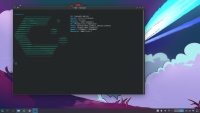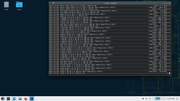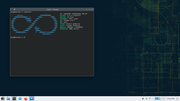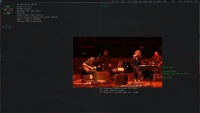You are not logged in.
- Topics: Active | Unanswered
#101 2024-03-25 16:43:52
- unklar
- Back to the roots 1.9

- From: #! BL
- Registered: 2015-10-31
- Posts: 2,771
Re: March 2024 Screenshot Thread
Offline
#102 2024-03-26 02:26:13
#103 2024-03-26 02:40:56
- hhh
- Gaucho

- From: High in the Custerdome
- Registered: 2015-09-17
- Posts: 16,470
- Website
Re: March 2024 Screenshot Thread
@PackRat, nice Cachy OS install (VM?). The release of Plasma 6 was a disaster, what's your opinion? 2.75G RAM usage, how much of that is cachy-browser? I can't tell from your btop. Thanks in advance!
I don't care what you do at home. Would you care to explain?
Offline
#104 2024-03-26 03:08:24
- hhh
- Gaucho

- From: High in the Custerdome
- Registered: 2015-09-17
- Posts: 16,470
- Website
Re: March 2024 Screenshot Thread
I better post this scrot before I break this install, Hyprland/Wayland with bells and whistles running as a (very!) usable desktop on Ubuntu 23.10. Floating windows shown for the scrot...
I haven't had a desktop with transparency and blur since fusilli WM (a Compiz fork) and that was ten years ago.
To the GNOME dev who decided to name his nautilus indexing daemon "tracker-miner-fs"... dude, really?
-edit- Finally figured out how to add blur to mako (notification)...
Last edited by hhh (2024-03-26 04:45:35)
I don't care what you do at home. Would you care to explain?
Offline
#105 2024-03-26 04:50:52
- Döbbie03
- Resident Metalhead

- From: New Zealand
- Registered: 2015-09-29
- Posts: 3,945
Re: March 2024 Screenshot Thread
@hhh, yup, Picom.
just in case you want them:
#################################
# Shadows #
#################################
# Enabled client-side shadows on windows. Note desktop windows
# (windows with '_NET_WM_WINDOW_TYPE_DESKTOP') never get shadow,
# unless explicitly requested using the wintypes option.
#
shadow = true;
# The blur radius for shadows, in pixels. (defaults to 12)
shadow-radius = 16;
#14
# The opacity of shadows. (0.0 - 1.0, defaults to 0.75)
shadow-opacity = 1.0;
# The left offset for shadows, in pixels. (defaults to -15)
shadow-offset-x = -16;
#-12
# The top offset for shadows, in pixels. (defaults to -15)
shadow-offset-y = -16;
#-12
# Red color value of shadow (0.0 - 1.0, defaults to 0).
# shadow-red = 0
# Green color value of shadow (0.0 - 1.0, defaults to 0).
# shadow-green = 0
# Blue color value of shadow (0.0 - 1.0, defaults to 0).
# shadow-blue = 0
# Hex string color value of shadow (#000000 - #FFFFFF, defaults to #000000). This option will override options set shadow-(red/green/blue)
#shadow-color = "#363636"
# Specify a list of conditions of windows that should have no shadow.
#
# examples:
# shadow-exclude = "n:e:Notification";
#
# shadow-exclude = []
shadow-exclude = [
"! name~=''",
"_GTK_FRAME_EXTENTS@:c",
"_NET_WM_STATE@:32a *= '_NET_WM_STATE_MAXIMIZED'",
"_NET_WM_STATE@:32a *= '_NET_WM_STATE_FULLSCREEN'",
"class_g = 'Conky'",
"class_g *?= 'firefox'",
"class_g *?= 'firefox-nightly'",
"class_g ?= 'LibreWolf'",
"class_g ?= 'floorp'",
"class_g ?= 'Chromium'",
"class_g ?= 'chromium'",
"class_g ?= 'Mercury Browser'",
"class_g ?= 'Mullvad Browser'",
"class_g ?= 'Tor Browser'",
"class_g ?= 'fragments'",
"class_g = 'transmission-gtk'",
"class_g = 'dwmsystray'",
"class_g = 'Slock'",
"class_g = 'slock'",
"class_g = 'Vivaldi-stable'",
"class_g = 'slock'",
"class_g = 'fragments'",
"class_g ?= 'Steam'",
"class_g ?= 'steam'",
"class_g = 'dwm'",
"_NET_WM_WINDOW_TYPE@:32a *= '_NET_WM_WINDOW_TYPE_DOCK'",
];
# Specify a X geometry that describes the region in which shadow should not
# be painted in, such as a dock window region. Use
# shadow-exclude-reg = "x10+0+0"
# for example, if the 10 pixels on the bottom of the screen should not have shadows painted on.
#
# shadow-exclude-reg = ""
# Crop shadow of a window fully on a particular Xinerama screen to the screen.
# xinerama-shadow-crop = false
#################################
# Fading #
#################################
# Fade windows in/out when opening/closing and when opacity changes,
# unless no-fading-openclose is used.
# fading = false
fading = true;
# Opacity change between steps while fading in. (0.01 - 1.0, defaults to 0.028)
# fade-in-step = 0.028
fade-in-step = 0.03;
# Opacity change between steps while fading out. (0.01 - 1.0, defaults to 0.03)
# fade-out-step = 0.03
fade-out-step = 0.03;
# The time between steps in fade step, in milliseconds. (> 0, defaults to 10)
# fade-delta = 10
# Specify a list of conditions of windows that should not be faded.
# fade-exclude = []
#
# Advanced Options
#
# Do not fade on window open/close.
# no-fading-openclose = false
# Do not fade destroyed ARGB windows with WM frame. Workaround of bugs in Openbox, Fluxbox, etc.
# no-fading-destroyed-argb = false
#################################
# Transparency / Opacity #
#################################
# Opacity of inactive windows. (0.1 - 1.0, defaults to 1.0)
# inactive-opacity = 1
inactive-opacity = 1;
# Opacity of window titlebars and borders. (0.1 - 1.0, disabled by default)
# frame-opacity = 1.0
frame-opacity = 1.0;
# Let inactive opacity set by -i override the '_NET_WM_OPACITY' values of windows.
# inactive-opacity-override = true
inactive-opacity-override = false;
# Default opacity for active windows. (0.0 - 1.0, defaults to 1.0)
# active-opacity = 1.0
# Dim inactive windows. (0.0 - 1.0, defaults to 0.0)
# inactive-dim = 0.0
# Specify a list of conditions of windows that should never be considered focused.
# focus-exclude = []
focus-exclude = [];
# Use fixed inactive dim value, instead of adjusting according to window opacity.
# inactive-dim-fixed = 1.0
# Specify a list of opacity rules, in the format `PERCENT:PATTERN`,
opacity-rule = [
"100:class_g = 'Bar'", # lemonbar
"100:class_g = 'slop'", # maim
"100:class_g = 'XTerm'",
"100:class_g = 'ncmpcpp'",
"100:class_g = 'URxvt'",
"90:class_g = 'kitty' && focused",
"80:class_g = 'kitty' && !focused",
"95:class_g = 'Alacritty'",
"95:class_g = 'St'",
"100:class_g = 'dunst'",
"100:class_g = 'Polybar'",
"100:class_g = 'firefox'",
"100:class_g = 'floorp'",
"100:class_g = 'Chromium'",
"100:class_g = 'micro'",
"100:class_g = 'Easytag'",
"100:class_g = 'Mercury Browser'",
"100:class_g = 'Mullvad Browser'",
"100:class_g = 'Tor Browser'",
"100:class_g = 'LibreWolf'",
"100:class_g = 'Vivaldi-stable'",
"100:class_g = 'transmission-gtk'",
"100:class_g = 'dwmsystray'",
"100:class_g = 'Steam'",
"100:class_g = 'steam'",
"100:class_g = 'dwm'",
"100:class_g = 'Thunderbird'",
"100:class_g = 'Thunar'"
];
# xinerama-shadow-crop = false
#################################
# Corners #
#################################
corner-radius = 10;
rounded-corners-exclude = [
# "window_type = 'normal'",
# "class_g ?= 'rofi'",
"class_g ?= 'polybar'",
"class_g ?= 'polybar'",
"class_g ?= 'eww-bar'",
"class_g ?= 'Dunst'",
"class_g = 'dwmsystray'",
"class_g = 'dmenu'",
"class_g ?= 'firefox'",
"class_g ?= 'Chromium'",
"class_g ?= 'chromium'",
"class_g ?= 'micro'",
"class_g ?= 'steam'",
"class_g ?= 'Steam'",
"class_g ?= 'transmission-gtk'",
"class_g ?= 'Vivaldi-stable'",
"class_g ?= 'LibreWolf'",
"class_g ?= 'Mercury Browser'",
"class_g ?= 'Mullvad Browser'",
"class_g ?= 'Tor Browser'",
"class_g ?= 'Slock'",
"class_g ?= 'slock'",
"class_g ?= 'qutebrowser'",
"class_g ?= 'floorp'",
"class_g ?= 'ncmpcpp'",
"class_g = 'dwm'",
"class_g ?= 'tint2'"
];
# Specify a list of border width rules, in the format `PIXELS:PATTERN`,
# Note we don't make any guarantee about possible conflicts with the
# border_width set by the window manager.
#
# example:
# round-borders-rule = [ "2:class_g = 'URxvt'" ];
#
round-borders-rule = [
"2:class_g ?= 'URxvt'",
];
#################################
# Background-Blurring #
#################################
#blur: {
# method = "dual_kawase";
# strength = 10;
# background = false;
# background-frame = false;
# background-fixed = false;
# kern = "3x3box";
#}
blur-method = "dual_kawase"
blur-deviation = 1.0
blur-strength = 8
blur-background = true
blur-background-frame = true
blur-background-fixed = true
blur-kern = "3x3gaussian"
blur-background-exclude = [
"window_type = 'dock'",
"window_type = 'desktop'",
"_GTK_FRAME_EXTENTS@:c"
]
transparent-clipping-exclude = [
"class_g = 'easyeffects'",
"_GTK_FRAME_EXTENTS@:c"]
# Exclude conditions for background blur.
blur-background-exclude = [
#"window_type = 'dock'",
"window_type = 'desktop'",
"class_g = 'Plank'",
"class_g = 'firefox'",
"class_g = 'LibreWolf'",
"class_g = 'Mercury Browser'",
"class_g ?= 'Mullvad Browser'",
"class_g ?= 'Tor Browser'",
"class_g ?= 'Chromium'",
"class_g ?= 'chromium'",
"class_g = 'dwmsystray'",
"class_g = 'Polybar'",
"class_g = 'dwm'",
"class_g = 'slock'",
"class_g = 'Slock'",
"class_g = 'Steam'",
"class_g = 'steam'",
"class_g = 'fragments'",
"class_g = 'transmission-gtk'",
"class_g = 'slop'",
"_GTK_FRAME_EXTENTS@:c"
];
#################################
# General Settings #
#################################
# Daemonize process. Fork to background after initialization. Causes issues with certain (badly-written) drivers.
# daemon = false
# Specify the backend to use: `xrender`, `glx`, or `xr_glx_hybrid`.
# `xrender` is the default one.
#
backend = "glx"
#backend = "xrender";
# Enable/disable VSync.
# vsync = false
vsync = true;
# Enable remote control via D-Bus. See the *D-BUS API* section below for more details.
# dbus = false
# Try to detect WM windows (a non-override-redirect window with no
# child that has 'WM_STATE') and mark them as active.
#
# mark-wmwin-focused = false
mark-wmwin-focused = true;
# Mark override-redirect windows that doesn't have a child window with 'WM_STATE' focused.
# mark-ovredir-focused = false
mark-ovredir-focused = true;
# Try to detect windows with rounded corners and don't consider them
# shaped windows. The accuracy is not very high, unfortunately.
#
# detect-rounded-corners = false
detect-rounded-corners = true;
# Detect '_NET_WM_OPACITY' on client windows, useful for window managers
# not passing '_NET_WM_OPACITY' of client windows to frame windows.
#
# detect-client-opacity = false
detect-client-opacity = true;
# Use EWMH '_NET_ACTIVE_WINDOW' to determine currently focused window,
# rather than listening to 'FocusIn'/'FocusOut' event. Might have more accuracy,
# provided that the WM supports it.
#
# use-ewmh-active-win = false
# Unredirect all windows if a full-screen opaque window is detected,
# to maximize performance for full-screen windows. Known to cause flickering
# when redirecting/unredirecting windows.
#
# unredir-if-possible = false
# Delay before unredirecting the window, in milliseconds. Defaults to 0.
# unredir-if-possible-delay = 0
# Conditions of windows that shouldn't be considered full-screen for unredirecting screen.
# unredir-if-possible-exclude = []
# Use 'WM_TRANSIENT_FOR' to group windows, and consider windows
# in the same group focused at the same time.
#
# detect-transient = false
detect-transient = true;
# Use 'WM_CLIENT_LEADER' to group windows, and consider windows in the same
# group focused at the same time. 'WM_TRANSIENT_FOR' has higher priority if
# detect-transient is enabled, too.
#
# detect-client-leader = false
detect-client-leader = true;
# Resize damaged region by a specific number of pixels.
# A positive value enlarges it while a negative one shrinks it.
# If the value is positive, those additional pixels will not be actually painted
# to screen, only used in blur calculation, and such. (Due to technical limitations,
# with use-damage, those pixels will still be incorrectly painted to screen.)
# Primarily used to fix the line corruption issues of blur,
# in which case you should use the blur radius value here
# (e.g. with a 3x3 kernel, you should use `--resize-damage 1`,
# with a 5x5 one you use `--resize-damage 2`, and so on).
# May or may not work with *--glx-no-stencil*. Shrinking doesn't function correctly.
#
# resize-damage = 1
# Specify a list of conditions of windows that should be painted with inverted color.
# Resource-hogging, and is not well tested.
#
# invert-color-include = []
# GLX backend: Avoid using stencil buffer, useful if you don't have a stencil buffer.
# Might cause incorrect opacity when rendering transparent content (but never
# practically happened) and may not work with blur-background.
# My tests show a 15% performance boost. Recommended.
#
# glx-no-stencil = false
# GLX backend: Avoid rebinding pixmap on window damage.
# Probably could improve performance on rapid window content changes,
# but is known to break things on some drivers (LLVMpipe, xf86-video-intel, etc.).
# Recommended if it works.
#
# glx-no-rebind-pixmap = false
# Disable the use of damage information.
# This cause the whole screen to be redrawn everytime, instead of the part of the screen
# has actually changed. Potentially degrades the performance, but might fix some artifacts.
# The opposing option is use-damage
#
# no-use-damage = false
use-damage = true;
# Use X Sync fence to sync clients' draw calls, to make sure all draw
# calls are finished before picom starts drawing. Needed on nvidia-drivers
# with GLX backend for some users.
#
# xrender-sync-fence = false
# GLX backend: Use specified GLSL fragment shader for rendering window contents.
# See `compton-default-fshader-win.glsl` and `compton-fake-transparency-fshader-win.glsl`
# in the source tree for examples.
#
# glx-fshader-win = ""
# Force all windows to be painted with blending. Useful if you
# have a glx-fshader-win that could turn opaque pixels transparent.
#
# force-win-blend = false
# Do not use EWMH to detect fullscreen windows.
# Reverts to checking if a window is fullscreen based only on its size and coordinates.
#
# no-ewmh-fullscreen = false
# Dimming bright windows so their brightness doesn't exceed this set value.
# Brightness of a window is estimated by averaging all pixels in the window,
# so this could comes with a performance hit.
# Setting this to 1.0 disables this behaviour. Requires --use-damage to be disabled. (default: 1.0)
#
# max-brightness = 1.0
# Make transparent windows clip other windows like non-transparent windows do,
# instead of blending on top of them.
#
# transparent-clipping = false
# Set the log level. Possible values are:
# "trace", "debug", "info", "warn", "error"
# in increasing level of importance. Case doesn't matter.
# If using the "TRACE" log level, it's better to log into a file
# using *--log-file*, since it can generate a huge stream of logs.
#
# log-level = "debug"
log-level = "warn";
# Set the log file.
# If *--log-file* is never specified, logs will be written to stderr.
# Otherwise, logs will to written to the given file, though some of the early
# logs might still be written to the stderr.
# When setting this option from the config file, it is recommended to use an absolute path.
#
# log-file = "/path/to/your/log/file"
# Show all X errors (for debugging)
# show-all-xerrors = false
# Write process ID to a file.
# write-pid-path = "/path/to/your/log/file"
# Window type settings
#
# 'WINDOW_TYPE' is one of the 15 window types defined in EWMH standard:
# "unknown", "desktop", "dock", "toolbar", "menu", "utility",
# "splash", "dialog", "normal", "dropdown_menu", "popup_menu",
# "tooltip", "notification", "combo", and "dnd".
#
# Following per window-type options are available: ::
#
# fade, shadow:::
# Controls window-type-specific shadow and fade settings.
#
# opacity:::
# Controls default opacity of the window type.
#
# focus:::
# Controls whether the window of this type is to be always considered focused.
# (By default, all window types except "normal" and "dialog" has this on.)
#
# full-shadow:::
# Controls whether shadow is drawn under the parts of the window that you
# normally won't be able to see. Useful when the window has parts of it
# transparent, and you want shadows in those areas.
#
# clip-shadow-above:::
# Controls wether shadows that would have been drawn above the window should
# be clipped. Useful for dock windows that should have no shadow painted on top.
#
# redir-ignore:::
# Controls whether this type of windows should cause screen to become
# redirected again after been unredirected. If you have unredir-if-possible
# set, and doesn't want certain window to cause unnecessary screen redirection,
# you can set this to `true`.
#
wintypes:
{
tooltip = { fade = true; shadow = true; opacity = 0.75; focus = true; full-shadow = false; };
dock = { shadow = false; clip-shadow-above = true; }
dnd = { shadow = false; }
popup_menu = { opacity = 0.8; }
dropdown_menu = { opacity = 0.8; }
};"All we are is dust in the wind, dude"
- Theodore "Ted" Logan
"Led Zeppelin didn't write tunes that everybody liked, they left that to the Bee Gees."
- Wayne Campbell
Online
#106 2024-03-26 05:04:10
- hhh
- Gaucho

- From: High in the Custerdome
- Registered: 2015-09-17
- Posts: 16,470
- Website
Re: March 2024 Screenshot Thread
^ Thanks much! We should add that to BL somehow. An alternate conf or a commented out, alternate shadow/radius setting.
I don't care what you do at home. Would you care to explain?
Offline
#107 2024-03-26 05:31:18
- hhh
- Gaucho

- From: High in the Custerdome
- Registered: 2015-09-17
- Posts: 16,470
- Website
Re: March 2024 Screenshot Thread
Last for the month, transparency and blur on all elements... window, panel, launcher/main menu, notification. I don't think I've ever had all elements properly blurred on a desktop with no artifacts before. Maybe on Plasma at one point.
I don't care what you do at home. Would you care to explain?
Offline
#108 2024-03-26 06:09:04
- Döbbie03
- Resident Metalhead

- From: New Zealand
- Registered: 2015-09-29
- Posts: 3,945
Online
#109 2024-03-26 06:09:21
- Döbbie03
- Resident Metalhead

- From: New Zealand
- Registered: 2015-09-29
- Posts: 3,945
Re: March 2024 Screenshot Thread
Great scrot by the way.
"All we are is dust in the wind, dude"
- Theodore "Ted" Logan
"Led Zeppelin didn't write tunes that everybody liked, they left that to the Bee Gees."
- Wayne Campbell
Online
#110 2024-03-26 06:29:25
- hhh
- Gaucho

- From: High in the Custerdome
- Registered: 2015-09-17
- Posts: 16,470
- Website
Re: March 2024 Screenshot Thread
Great scrot by the way.
Thanks. I mean, if I figure out how to do shadows on mako and fuzzel, I'll post another, but that's not going to happen. I've already done the research. ![]()
I don't care what you do at home. Would you care to explain?
Offline
#111 2024-03-26 06:33:34
- Döbbie03
- Resident Metalhead

- From: New Zealand
- Registered: 2015-09-29
- Posts: 3,945
Re: March 2024 Screenshot Thread
Hypr, Wayland, they aren't my friends. Until I purchase a decent alternative to my RTX 3060 I am using X11 and my bestest of buddies, dwm.
Shadows, a working desktop, stability, ease of use these aren't things that a Wayland based wm can bring me unfortunately.
"All we are is dust in the wind, dude"
- Theodore "Ted" Logan
"Led Zeppelin didn't write tunes that everybody liked, they left that to the Bee Gees."
- Wayne Campbell
Online
#112 2024-03-26 07:07:49
- hhh
- Gaucho

- From: High in the Custerdome
- Registered: 2015-09-17
- Posts: 16,470
- Website
Re: March 2024 Screenshot Thread
I don't know, that sounds like Nvidia talking. My modest laptop...
rachael@tyrell-corp:~$ inxi -b
System:
Host: tyrell-corp Kernel: 6.5.0-26-generic arch: x86_64 bits: 64
Desktop: Hyprland Distro: Ubuntu 23.10 (Mantic Minotaur)
Machine:
Type: Laptop System: LENOVO product: 81X7 v: IdeaPad 3 14ITL05
serial: <superuser required>
Mobo: LENOVO model: LNVNB161216 v: SDK0T76475 WIN
serial: <superuser required> UEFI: LENOVO v: GCCN35WW date: 09/05/2023
Battery:
ID-1: BAT0 charge: 33.4 Wh (100.0%) condition: 33.4/35.0 Wh (95.4%)
CPU:
Info: dual core 11th Gen Intel Core i3-1115G4 [MT MCP] speed (MHz): avg: 626
min/max: 400/4100
Graphics:
Device-1: Intel Tiger Lake-LP GT2 [UHD Graphics G4] driver: i915 v: kernel
Device-2: Bison Integrated Camera driver: uvcvideo type: USB
Display: wayland server: X.Org v: 1.23.2 with: Xwayland v: 23.2.0
compositor: Hyprland driver: X: loaded: modesetting unloaded: fbdev,vesa
dri: iris gpu: i915 resolution: 1920x1080~60Hz
API: OpenGL v: 4.6 Mesa 23.2.1-1ubuntu3.1 renderer: Mesa Intel UHD
Graphics (TGL GT2)
Network:
Device-1: Intel Wi-Fi 6 AX201 driver: iwlwifi
Drives:
Local Storage: total: 119.24 GiB used: 69.76 GiB (58.5%)
Info:
Processes: 214 Uptime: 5h 52m Memory: total: 12 GiB available: 11.48 GiB
used: 2.21 GiB (19.2%) Shell: Bash inxi: 3.3.29I jest. I wouldn't even be messing with Hyprland, but GNOME Wayland cured all my Intel graphics woes, so I was curious about other Wayland compositing WMs. And down the rabbit hole I went.
I don't care what you do at home. Would you care to explain?
Offline
#113 2024-03-26 09:57:32
- PackRat
- jgmenu user Numero Uno

- Registered: 2015-10-02
- Posts: 2,733
Re: March 2024 Screenshot Thread
@PackRat, nice Cachy OS install (VM?). The release of Plasma 6 was a disaster, what's your opinion? 2.75G RAM usage, how much of that is cachy-browser? I can't tell from your btop. Thanks in advance!
I installed to metal; I wanted to see if Arch-based and Plasma-6 was easier on the CPU than Void with Plasma5. A bit better, but I'll find out for sure when I use it later today.
The memory use is from the Cachy browser (firefox/librewolf configuration) and krita (KDE equivalent to gimp) running at the same time.
Last edited by PackRat (2024-03-26 10:00:09)
You must unlearn what you have learned.
-- yoda
Offline
#114 2024-03-26 10:09:19
- PackRat
- jgmenu user Numero Uno

- Registered: 2015-10-02
- Posts: 2,733
Re: March 2024 Screenshot Thread
The release of Plasma 6 was a disaster, what's your opinion?
Plasma6 itself is fine; although I haven't used it too much yet. The graphics were good (Intel and AMD gpu here) and it was stable. Really cranks the old AMD CPU (that laptop came with Win 8 installed, just before 10 was released to give you an idea of its age).
As far as something from the KDE store wiping the computer out, that is always the risk when getting some 3rd party software. Packages from the AUR have messed up my systems twice. Back in the #!/BL Hydrogen days.
You must unlearn what you have learned.
-- yoda
Offline
#115 2024-03-26 13:41:48
- Nili
- Member

- From: $HOME/♫♪
- Registered: 2015-09-30
- Posts: 1,278
- Website
Re: March 2024 Screenshot Thread
I like Plasma so much, specifically My hardware Intel® Core™ i7-10700 CPU @ 2.90GHz like it so much.
Four years ago when my 10gen Intel it was a new shiny release, due to the fact that it was new for Linux, there were strong hangs moments in Wayland, bugs things were fixed along the way, so the present is going fine.
Honestly, I'm not going back to X11/X server. I left all my favorite WM behind to stick on Plasma.
My desktop really likes it.
Regarding the incident encountered with that user lost his data, Such accidents where dangerous commands are given authorization ie: When we set the pass to install SDDM Login Themes, what can not be expected? I refuse to install global themes. I don't use SDDM, i go to command line for entering the desktop, I change only the KDE color-schemes where i review myself that few KiB code into this particular theme. Nothing else, nothing more. However, absolute security cannot be said to exist, every time something will come out from other parts intentionally or not.
Tumbleweed / KDE
Offline
#116 2024-03-26 17:00:45
Offline
#117 2024-03-26 17:29:54
- shortarcflyer
- Banned

- Registered: 2022-04-27
- Posts: 408
Re: March 2024 Screenshot Thread
Recent Archbang screenshot. Not many packages required to make this distro work as opposed to other distros that drag in a bunch of un-neccessary bloat. Mem usuage includes firefox running with 12 tabs open.
Last edited by shortarcflyer (2024-03-26 17:34:12)
I use Arch BTW! If it is not rolling, it is stagnant!
RebornOS, EndeavourOS, Archbang, Artix,
Linuxhub Prime, Manjaro, Void, PCLinuxOS
Offline
#118 2024-03-26 22:29:14
- shortarcflyer
- Banned

- Registered: 2022-04-27
- Posts: 408
Re: March 2024 Screenshot Thread
PCLinuxOS openbox wm with wallpaper made at playgroundai. Mem usuage is with firefox running and 10 tabs open.
Last edited by shortarcflyer (2024-03-26 22:30:01)
I use Arch BTW! If it is not rolling, it is stagnant!
RebornOS, EndeavourOS, Archbang, Artix,
Linuxhub Prime, Manjaro, Void, PCLinuxOS
Offline
#119 2024-03-28 18:39:24
#120 2024-03-29 01:29:58
- shortarcflyer
- Banned

- Registered: 2022-04-27
- Posts: 408
Re: March 2024 Screenshot Thread
Reinstalled Mageia 9 on my testing laptop to play around with just for fun. Openbox WM and stock wallpaper. This install was a net install so I could custom pick the items I wanted installed.
Last edited by shortarcflyer (2024-03-29 01:30:37)
I use Arch BTW! If it is not rolling, it is stagnant!
RebornOS, EndeavourOS, Archbang, Artix,
Linuxhub Prime, Manjaro, Void, PCLinuxOS
Offline
![[BunsenLabs Logo]](/img/bl.svg)














